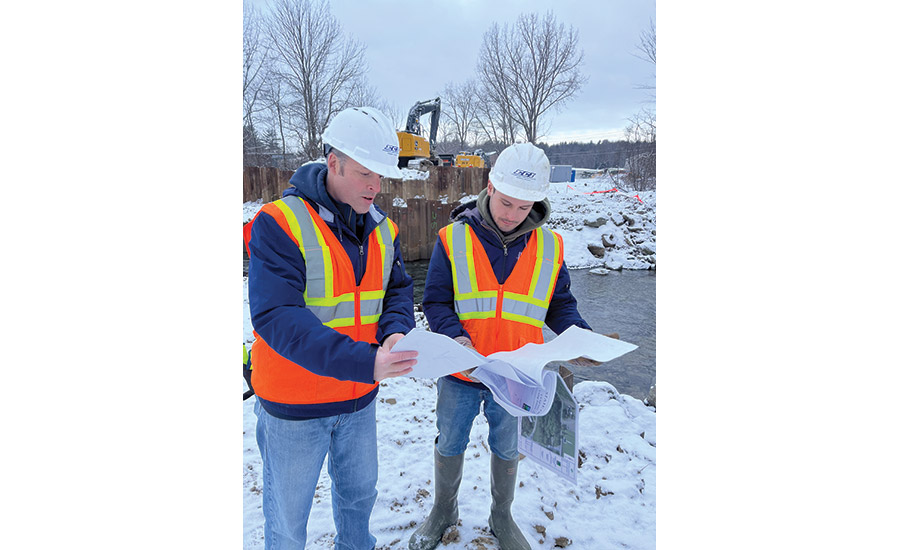ENR 2023 Top 25 Newsmakers
Benjamin Heath: Led Team to Quickly Install Bypass After Vermont Sewer Pipe Failure

Heath (left) on Burlington site with project engineer Jeremy Dean, took a novel approach to installing a mile-long temporary bypass above ground, using components that were easiest to procure for a temporary fix. Once the bypass was in place, the city began work to develop a permanent solution.
Photo courtesy Engineers Construction Inc.

Related Article:
Vermont Contractors Tackle Flood-Damaged Infrastructure
Back to:
25 Top Newsmakers
Following Vermont’s record flash flooding last July 10-11 that killed two people and caused about $682 million in infrastructure damage, Benjamin Heath, civil construction manager at Engineers Construction Inc., received an emergency call from Burlington city officials that a 24-in.-dia sanitary sewer pipe had breached. Wastewater was no longer entering the city treatment plant, and officials had little information about the underwater pipe that had leaked an estimated 3 million gallons of sewage into the Winooski River.
As the city’s on-call service contractor, the Williston, Vt.-based company’s team led by Heath persuaded officials not to pump sewage into a nearby sanitary sewer manhole, which gravity drains into the plant. Seemingly a “great solution, it risked overflowing and backflowing sewage into residents’ basements,” Heath says. The team instead built a temporary pump station on the river’s southern side and then installed a mile-long temporary sanitary sewer pipe to the city’s wastewater treatment plant.
Heath used “design expertise and his ingenuity in devising the plan to install almost one mile worth of fused HDPE [high density polyethylene] pipe above ground within five days,” says Ashley Walenty, city water resources engineer. Heath also suggested designing a 2,500-gallon above-ground precast concrete tank, allowing sewage to discharge and slowly flow by gravity out of the new pump station into the existing one. “This decreased the velocity of the bypass pumping forcemain [pipe] to a gravity system at the discharge point to ensure our manholes were protected,” Walenty says.
Heath needed “the best idea that can happen now” to stop the sewage from entering the river and then flowing into Lake Champlain, he says. Designers were still calculating fluid dynamics math for the pipe and pump configuration as crews headed to the site and the project team began to procure rugged, thick-walled HDPE pipe welded by butt fusion.
“We started calling our vendors and sent people driving all over New England with tractor trailers to pick up pipe right out of their inventories,” Heath says. Within 24 hours, the team had “loads of pipes showing up on the site with fittings, valves, bends, workforce and equipment,” he says.
The design still was incomplete when workers “started butt fusing pipe across the ground in an alignment that went through private properties, city properties and several driveways along city streets,” Heath says.
The team also assisted with a monthlong, $1.2-million in-river repair that had the sanitary sewer pipe back in service by Nov. 8. This work required barges, divers and multiple excavators to locate the break. “Divers were in the river directing excavators on the barges to help place the straps to remove and then ultimately replace 125 ft of 24-in.-dia ductile iron pipe in the river and an additional 100 ft from the riverbank to the discharge manhole,” Walenty says. This enabled the team to decommission temporary bypass pumps and sanitary sewer pipe to alleviate winter freezing concerns for the above-ground system.
Heath credits his quick problem-solving ability to his civil engineering degree earned at the University of Vermont, where he was trained to “learn everything I can about the problem quickly, and develop a solution.”




